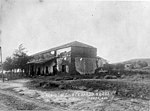Oak Canyon Nature Center
Education in Anaheim, CaliforniaGeography of Anaheim, CaliforniaNature centers in CaliforniaNature reserves in CaliforniaProtected areas of Orange County, California ... and 1 more
Tourist attractions in Anaheim, California

Oak Canyon Nature Center is a nature preserve located in Anaheim, Southern California. Owned by the city, the park spans an area of 58-acres (23 hectares), comprising three adjoining canyons of the Santa Ana foothills. It has an elevation range from 525 to 825 feet (160 to 251 m)., and contains three major vegetation zones: coastal sage scrub, oak woodland and riparian. Open on weekends, the John J. Collier Interpretive Center features a museum with live animal and regional natural history exhibits. The center offers nature education programs and summer camp programs.
Excerpt from the Wikipedia article Oak Canyon Nature Center (License: CC BY-SA 3.0, Authors, Images).Oak Canyon Nature Center
South Camino Grande, Anaheim
Geographical coordinates (GPS) Address Nearby Places Show on map
Geographical coordinates (GPS)
| Latitude | Longitude |
|---|---|
| N 33.83742 ° | E -117.75342 ° |
Address
Oak Canyon Nature Center
South Camino Grande
92808 Anaheim
California, United States
Open on Google Maps






